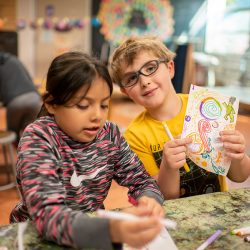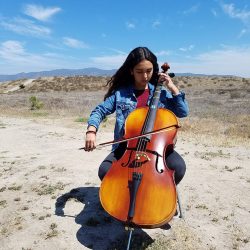
PBL Design Camp
Welcome, Design Campers!
Thank you for joining us on this two-week adventure where we will connect and collaborate to support each other in designing our own projects. The essential question for our journey is “How do we design experiences that increase student engagement and deeper learning?” This password protected website gives you access to the resources, agendas, and EdTech you will need to participate.
Project-based learning (PBL) is a teaching model used at High Tech High for educators to facilitate deeper learning experiences for students. In PBL the project guides student learning and creates “need to know” situations that generate the necessary content, skill, and mindsets for academic and social emotional growth.
In this two-week workshop we will practice and internalize the project design process. We’ll use the lens of student engagement and deeper learning to reflect on and assess our work with our design partners throughout the week. At the end, campers will have the structures to support each other in future project design and planning opportunities.
We will meet Monday, Wednesday, and Friday on Zoom for synchronous, collaborative work time. In this website you will find the resources needed for asynchronous work time. We encourage participants to check-in on Tuesday and/or Thursday for office hours so we can provide you with additional personalized support with your project.
Continue to sift through the resources on this website to collect your camp gear, complete the pre-work, and practice your EdTech skills to jump into our collaborative project design sessions. As PBL Design Camp Counselors, we are here to guide you through the next two weeks of project design. Let’s get started!
PBL Design Gear
You won’t need bug spray!
Camping equipment isn’t required for this expedition, but here are some items you might find handy:
- Trusty laptop. Additional tablet or phone devices are recommended, but not essential
- Sticky notes
- Sharpies or Markers
- Journal or Paper
- Black pen
- Snacks or brain food
- Water
- Contact information to current student, or school-aged child to ask for support
- Favorite mindfulness activity to keep an open mindset with technology


Camp Counselors
You will meet one or more of our Professional Learning Team during camp. Please feel free to reach out if you have any questions.
Pre-Work
Get Your Mind Ready to Design
Before you join your first session, complete the following pre-work.
Please read our norms for when working with HTH students at PBL Design Camp Online.
Your reflection will be put into practice immediately as we embark on building empathy for ourselves and others. Complete a Flipgrid post introducing yourself and sharing your transformative learning experience. A unique camp Flipgrid code has been emailed in the welcome email. All Flipgrid reflections can be found here.
Open this Transformative Learning Experience Reflection handout to guide your reflection.
- Reflection Prompt: When was a time when you had a transformative learning experience in or out of school? This is a moment when your thinking or perspective about yourself or the world changed.
EdTech will be modeled and used throughout PBL Design Camp. If you are not able to attend one of the training sessions or office hours, follow these EdTech slides or links for tutorial videos:
- PBL Design Camp EdTech session slides
- Zoom: for whole group and small group discussions. You can open a window for Zoom or download this app onto your computer
- Miro: for ideation, collaboration and critique – no need to sign-up, we will provide a link on Monday
- Flipgrid: for video daily reflections. Participants will share and receive feedback from colleagues and facilitators asynchronously
- Menti: for polling and creating word clouds of participant perspectives, no sign up need, code will be shared during the meeting.
HTH Resources for PBL Design Camp. The golden rule of camping is “be prepared.” Here are some resources you can use to make the most of your experience with us:
- Why Projects? Video (3.5 minutes)
- One-minute hit: We are tight on the HOW of planning, not the what Video (1 minute)
- HTH Virtual Tour Overview of HTH schools and student experience (2 minutes)
- PBL is a type of unit, not a type of lesson Video (1 minute)
- Deeper Learning competencies have been woven into PBL Design Camp, learn more here.
- UnBoxed is a repository of PBL resources to listen to or read.
- Project Cards are a great starting point for project inspiration.
- Share Your Learning campaign provides educators with resources for students to share their work publicly. Check out the new resources for sharing your learning during distance learning.

PBL Design Camp Sessions
One Workshop. Six Design Sessions.
Practice structures and strategies for community building and empathy work. The foundation of teaching is empathy: understanding others’ perspectives, experiences, and needs to foster transformational learning experiences.
Inspiration for projects comes from anywhere and everywhere! Harnessing these ideas into solid project plans takes a bit more refinement. In this session we will practice strategies to generate project ideas collaboratively and individually.
We use HTH project models to identify the structures and rhythm of thoughtfully designed projects. As participants reconstruct the puzzles, structures and routines in PBL are uncovered. These models will provide examples for when we create our own, unique pieces of a project plan.
To develop the first draft of a PBL project we will practice rapid focused ideation strategies. Keeping in mind the structures and rhythms we noticed in the previous session the rapid ideation will be focused by specific themes. Continuing the puzzle analogy, in groups of three you will create and sort the PBL puzzle pieces of your very own project by the end of this session.
The final session is our gathering around the metaphorical campfire to lend support to each other and reflect on our experience of the design process. We will practice participating in a staple discussion protocol that structures constructive feedback. And we will share our promises of learning.
Session 1
Empathize / Define
Teaching is personal. In a room of many perspectives, experiences, and needs, it can be a challenge to reach and support all students. Understanding our students allows for a deeper learning experience in the classroom. The more we know where our students are coming from and their perspectives, the more we can frame classroom activities and experiences to support students’ academic and social/emotional growth. We need to build empathy for ourselves and our students, and to support students in building empathy towards others. This workshop practices structures and strategies for community building and empathy work.
What values, experiences, strengths, and needs are WE bringing to the conversation? Today we are going to focus on exploring the values, experiences, strengths and needs WE, as educators, use in learning environments. Our classrooms illustrate our values. How do we ensure that we are listening to our students so that our classrooms are a space for everyone to grow?
| Session 1: EMPATHIZE/DEFINE | OCT2020 Participants Slides |
SESSION 1 AGENDA
| Activity | Purpose |
| Introductions & Commitments for Online Collaboration | Welcome introduction of participants and student consultants. Commitments for engaging in a collaborative online environment. |
| Education Design Process and Purpose of Empathy Session | The journey will start with building EMPATHY. We will share several practices we use to build empathy for ourselves and for our students. What are the values, experiences and strengths that students, families, teachers, and colleagues bring into the school or classroom?
The empathy component takes vulnerability and courage. The project design process is emotional and personal. |
| Transformative Learning Experience Reflection | Personal reflection and protocol to build EMPATHY. Co-create a project rubric for transformative experiences in our schools and classrooms. |
| Transformative Learning Experience Meta-Reflection | Discuss and analyze the use of Transformative Learning Experience reflection as the first step of the design process.
This reflection begins to help us DEFINE our goals as educators. |
| Dialogical Interview Protocol | Dialogical Interview protocol has specific structures for listening and asking questions that lead to deeper understanding between two people.
We will model and practice facilitating a space to connect with a colleague for participants to use with potential collaborators at their school. The goal is to notice what people bring with them that shapes our schools and classrooms. |
| Put it to Practice: Empathy Interview | Set expectations for building empathy with and for students.
|
| Educator’s Impact Statement | DEFINE our purpose and opportunity to reflect on the values we bring into the classroom. |
| Feedback Survey | Practice giving kind, specific and helpful feedback to shape the following sessions depending on the unique needs of the group. |
EMPATHIZE/DEFINE RESOURCES
| What We Practice
Empathize/Define Session |
Purpose of Activity | Put it to Practice
Complete by Ideation Session |
| Transformative Learning Experience | Identify characteristics of purposeful, meaningful learning experiences. Co-create rubric to assess our project designs for deeper learning opportunities. | Revise “rubric” to focus on three characteristics |
| Dialogical Interview Protocol | Connect and build empathy with colleagues. Use this visual guide from our friends at Stanford d.school to practice noticing, listening and internalizing the phases of an empathy interview. | Empathy Interview
Practice asking questions and listening by conducting an Empathy Interview with a student, colleague, friend, family member, other? |
| Educator’s Impact Statement | To DEFINE our North Star for our practice. And NOTICE what experiences and values we bring to our work. | Living statement of purpose. We will revise as needed over the course of this workshop.
POST Educator’s Impact on FLIPGRID before next session. |
Session 2
Define / Ideate
Once you start to design projects, it is difficult not to see a project in everything around you. In this session, we ask participants to dream big and to allow the everyday constraints to fade into the background. If there were few constraints, what would you make, build, or do with students? Three minds are better than one for ideation, now imagine what 24 minds can dream up! Through this expansive exploration we then narrow down for individual project ideas using a series of prompts and strategies to find an inspirational and workable project idea.
| Session 2: DEFINE/IDEATE | OCT2020 Participants Slides |
SESSION 2 AGENDA
| Activity | Purpose |
| Community Building Activity & Online Commitments for Collaboration | Model connection activity to use with your students. Ground ourselves in our online commitments to be most present throughout the session. |
| Gallery Walk: Educator’s Impact Statement | Share our North Star statements with each other. |
| 50 Things Ideation Protocol | Strategy to rapidly generate IDEATE project ideas collectively. |
| Define Audience
Community Partners: Purpose and Impact |
To transition our project ideas to the following phase of project design we will think critically to respond to the following questions:
Typically, who is the audience to student learning? How can we include community partners into our project design? What happens to student engagement when we connect with professionals? How are students and the community partners impacted when they engage in collaboration for student learning? |
| Grounding Our Work | DEFINE our purpose with students. What matters to you in your classroom? What is ONE non-negotiable? What is the application or where do we see it in their world? |
| Idea Selection | We will use our North Stars to guide us as we intentionally choose a project idea to further IDEATE and develop. |
| Zero Draft Mind Map | Prepare to create a DRAFT of our project idea with a focus on purpose for and impact on the community (students, parents, |
| Exit Survey | Gather feedback to support next session |
DEFINE/IDEATE RESOURCES
| What We Practice
Define/Ideate Session |
Purpose | Put it to Practice
Complete by Draft (PBL Project Model) Session |
| 50 Things Ideation Protocol | Protocol to generate project ideas collectively. | Create a Zero Draft Mind Map of initial project design on Miro |
| Educator’s Impact Statement: Grounding Our Work | Reflect on your most recent Educator’s Impact Statement to choose a project idea that embodies the goals you have set for your classroom, and self. | Select ONE project idea to DRAFT in the following sessions |
| Community Partners: Purpose and Impact Hierarchy of Audience (source: Ron Berger and Innovation Unit) | Community connection. Who could you invite to collaborate with your students for a relevant project? | Reflect on the purpose and impact of the project on students and audience
POST Zero Draft Mind Map on FLIPGRID before session 3 |
Session 3
Draft: PBL Project Models
Models are a critical part of setting student expectations for a professional product, artifact, or experience. We have deconstructed several HTH projects to identify the structures and rhythms of a thoughtfully designed plan to create PBL puzzles. Have you sat around a table and engaged in reconstructing a puzzle lately? Using Miro.com and in small groups you will engage in discussion to identify the essential elements that are needed to be replicated in our own project design. By the end of the session, we will co-create a checklist of project essentials before creating your very own project plans.
| Session 3: DRAFTS (PBL Project Models) | OCT2020 Participants Slides |
SESSION 3 AGENDA
| Activity | Purpose |
| Survey Reflections & Online Commitments for Collaboration | We See You, We Hear You. As facilitators we model the importance of staying flexible to the needs of participants.
Ground ourselves by selecting an online commitment for this session. |
| Community Building Activity | Contribute your artistic perspective to a group portrait. In this playful drawing activity the importance of using a MODEL to create your best work is highlighted. |
| PBL Puzzles Protocol: Dissecting a Model | A step-by-step protocol to work through pieces of a project model. Move through the steps of the protocol to reveal and identify the structures that support project implementation. |
| Routines, Rhythms, and Structures of PBL project | Debrief the structures and rhythms of thoughtfully designed projects and apply to our own projects. |
| Put it to Practice | Find a professional model to analyze and dissect for the project you will DRAFT in the next session. |
| Exit Survey | Feedback from each and every group member is essential for us to support all participants and the development of this work. |
DRAFT (PBL Project Models) RESOURCES
| What We Practice
Draft (PBL Project Models) Session |
Purpose | Put it to Practice
Complete by Draft/Ideate Session |
| HTH PBL Design Kit | Watch and listen to how PBL project structures and rhythms are included at High Tech High K-12 schools. | Rewatch the videos highlighted in today’s DRAFT (PBL Models) session.
Explore the resources included with each video. |
| PBL Puzzles Protocol | Analyze and dissect project models to identify structures and rhythms of a project design. | Find a professional model of what students will make, build, or do.
Analyze its qualities to guide your project design. POST a Professional Model reflection on Flipgrid before session 4 |
Session 4
Ideate / Draft
We use the improv rule of “Yes, and…” to build an optimistic, playful ideation culture. Improv scenes rarely become movies, it takes several rounds of critique and refinement to create a final product from an initial improv session. But the idea that we must start somewhere and build from there guides this session. To develop our first draft of a PBL project we will facilitate focused and timed ideation prompts for a small group of divergent perspectives. With optimism and openness fueling the groups creativity, participants will internalize the “Yes, and…” protocol to collectively produce the pieces of a PBL Project.
| Session 4: IDEATE/DRAFT | OCT2020 Participants Slides |
SESSION 4 AGENDA
| Activity | Purpose |
| Survey Reflections & Online Commitments for Collaboration | We See You, We Hear You. As facilitators we model the importance of staying flexible to the needs of participants. Ground ourselves by selecting an online commitment for this session. |
| Community Building Activity | To connect with colleagues and a low stakes introduction to the purpose of workshop activities. |
| PBL Puzzle Peer Review | Reconnect with the rhythms and structures of a project that were identified in the previous session. |
| “Yes, and…” Protocol Part I | Introduce the “Yes and…” protocol that is inspired from theater improv to rapid IDEATE. You will unleash all project ideas in 5 min to start a project DRAFT. |
| Ideation Poster | As a project designer, you will organize your ideas on the ideation poster in preparation to present a DRAFT of your project to a small group. |
| “Yes, and…” Protocol Part II & Part III | Working in groups of three with a timer in hand you will IDEATE focused on the structures and rhythms of a PBL project. |
| First draft PBL Project Pieces | Debrief how successful the “Yes and…” protocol was in facilitating rapid ideation in a small group of divergent perspectives. |
| Put it to Practice | Use the project ideation poster to organize your project pieces and highlight success and gaps in your first DRAFT of a PBL project. |
| Exit Survey | Feedback from each and every group member is essential for us to support all participants and the development of this work. |
IDEATE / DRAFT RESOURCES
| What We Practice
Idate/Draft Session |
Purpose | Put it to Practice
Complete by Test Session |
| “Yes and…” Protocol | Focused ideation to develop your own project puzzle pieces for your first DRAFT of your project. | Add ideas to your project ideation poster. Challenge option to do a “Yes, and…” protocol with students for your project idea. |
| Project Ideation Poster | Organize project pieces to identify strengths and areas that still need to be developed. | Post a reflection of your completed Ideation Poster before session 5 |
Session 5
Testing
In this session, we test the project by examining what is at the heart of the project. We collaboratively design project impact statements and layout a draft calendar. We test the components of the project using the lens of student engagement and learning. The goal is transformative learning experiences for students and we calendar the pieces of our project by following the structures and rhythms identified in earlier sessions. A well-planned PBL project follows cycles of essential design elements outlined in HTH’s PBL Design Kit.
| Session 5: TEST | OCT2020 Participants Slides |
SESSION 5 AGENDA
| Activity | Purpose |
| Survey Reflections & Online Commitments for Collaboration | We See You, We Hear You. As facilitators we model the importance of staying flexible to the needs of participants. Ground ourselves by selecting an online commitment for this session. |
| Community Building Activity | To connect with colleagues and low stakes introduction to the purpose of workshop activities. |
| Project Impact Statement | DRAFT a North Star for your project. What is the why, purpose, and impact of the project? |
| Test Project Impact Statement | With your camp buddy TEST the project’s impact statement. Goal is to receive peer critique to refine the project’s statement for clear purpose and impact. |
| Grounding Our Work | This reflection puts the project impact statement to the test and will help us evaluate and TEST the “core” of the project. |
| Calendar the Project | Work in cycles and backwards design the deliverables for the project. |
| Engagement/Learning Test | Collaborate with colleagues and TEST each piece of the project for engagement, learning, and transformative potential. |
| Put it to Practice | Reflect on the structures used in this session to TEST your project. Use the Project Self-Assessment handout to reconnect with the characteristics of Transformative Learning. |
| Exit Survey | Feedback from each and every group member is essential for us to support all participants and the development of this work. |
TEST RESOURCES
| What We Practice
Test Session |
Purpose | Put it to Practice
Complete by Critique Protocol Session |
| Project Impact Statement and Grounding Our Work | DEFINE the core purpose of your project. | As you calendar the draft of your project plan, refer back to the Project Impact Statement and Grounding Our Work to ensure that you are meeting the goals of the project. |
| Engagement/Learning Test | TEST the pieces of your project for high levels of student engagement and student learning | Refine your project design with the lens of engagement and learning. |
| Project Self-Assessment Reflection | To what extent does your project design provide transformative learning moments? Practice a self-assessment structure to support growth and confidence as a project designer. | Post your project Self-Assessment reflection before session 6 |
Session 6
Critique
Each session holds space for self reflection. Reflection is a necessary component of growth and understanding. For this final session we introduce protocols that support digging deeper into our design motivations. We practice structures that elicit constructive feedback and personal reflection. As educators move forward as project designers, reflection and refinement become ingrained in our daily planning. We strive to create engaging experiences for students that will lead to deeper learning and to do this we must constantly reevaluate what is at the heart of our plans. And these structures help us become more vulnerable and open to feedback and refinement.
| Session 6: CRITIQUEOCT | OCT2020 Participants Slides |
SESSION 5 AGENDA
| Activity | Purpose |
| Survey Reflections & Online Commitments for Collaboration | We See You, We Hear You. As facilitators we model the importance of staying flexible to the needs of participants. Ground ourselves by selecting an online commitment for this session. |
| Gallery Walk Critique | Prepare an effective gallery walk for critique. Austin’s Butterfly is a great resource for introducing Kind, Specific and Helpful feedback. |
| Overview of Protocols | Protocols are structures for having conversations and thinking through dilemmas in our practice together. |
| Project Tuning Protocol | Dive deeply into one project and support the designer in structured feedback around a focus question. |
| Debrief of Protocol | What surprised you about the protocol? What implications does this have for your own project design and teaching practice? |
| Promises of Learning | Our students at HTH end each semester with a Presentation of Learning. We will end our session with a PROMISES of Learning. 2 minute structured reflection about takeaways. |
| Closing Community Circle | Final share out and connection to the group. |
| Put it to Practice | Reflect on the sessions and present your learning on flipgrid. |
| Exit Survey | Feedback from each and every group member is essential for us to support all participants and the development of this work. |
CRITIQUE RESOURCES
| What We Practice
Critique Protocol Session |
Purpose | Put it to Practice
Complete by following week |
| Peer Feedback | Gallery walk critique to provide thoughtful feedback to all participants | Facilitate a peer feedback session for your students. Set up the expectations and time for students to practice giving and receiving feedback. Austin’s Butterfly is a model for how to give kind, specific, and helpful feedback. |
| Project Tuning Protocol | Focused time to dive deeply into one project and provide feedback around a focus question. | Facilitate a tuning protocol for a colleague to practice setting expectations and adhering to protocol structures. OR host a project tuning and invite students! |
| Promises of Learning | Reflect on our learning and share with colleagues. | Post your final Promise of Learning reflection on Flipgrid (once posted please contact as if you are seeking CEU from High Tech High Graduate School of Education) |










